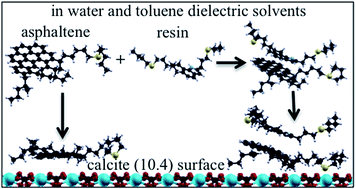Adsorption of asphaltenes on the calcite (10.4) surface by first-principles calculations
Abstract
Asphaltenes play a key role in oil production and its exploration from natural reservoirs. In carbonate reservoirs, the calcite (10.4) surface retains asphaltenes. However, its aggregate structure and deposition process are not fully understood. Using first-principles calculations based on density-functional theory (DFT) with van der Waals (vdW) dispersion, we studied the adsorption of asphaltene, resin and resin–asphaltene dimer molecular models on the CaCO3 surface in the presence of a dielectric water–toluene environment. These large molecules impose a challenging description at the electronic level. Our calculations indicate that there is a minor steric hindrance in the effective interaction of the aromatic region of asphaltene on the calcite surface. However, aliphatic chains with sulphide groups can play a significant role on the adsorption process and its availability to receive electronic charge density from the surface. Accordingly, the preferential LUMO localized in the aromatic region of asphaltene may also allow the adsorption on the calcite surface and π–π stacking interactions. Initially, the resin molecule tends to be trapped during dimer formation with the asphaltene, whereas a significant intramolecular charge rearrangement due to the heteroatoms is necessary to increase the π–π stacking interactions. For the dimer, the adsorbed form of asphaltene favors more available electronic states to increase the likelihood of nanoaggregation. Therefore, changes in the continuum dielectric constant only had a minor effect on the calculated adsorption energies. Experimental work related to the oil–water interface in the presence of toluene show similar behavior during asphaltene adsorption. Our studies indicate that nanoaggregates are grown through resin and the calcite (10.4) surface selectively adsorbs the less polar asphaltenes from oil.

- This article is part of the themed collection: SBQ-RSC: Celebrating UK-Brazil collaborations


 Please wait while we load your content...
Please wait while we load your content...